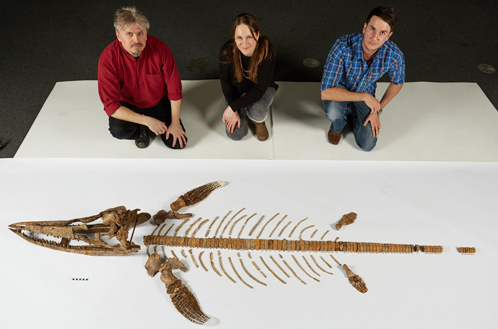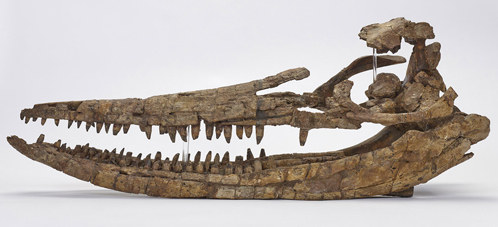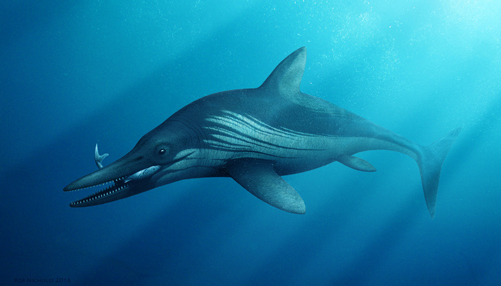Manchester University Palaeontologist Helps Build an Ichthyosaur
The fossilised remains of a large Ichthyosaurus, one of the biggest specimens of a “fish lizard” found in the British Isles, goes on display today as a new gallery opens at the Birmingham Thinktank Museum. Providing an exciting centrepiece to the new Marine Worlds Gallery, the fossils may represent an entirely new species of ichthyosaur.
The Skull of the Warwickshire Ichthyosaurus
Picture credit: Birmingham Thinktank
A Manchester Palaeontologist
Dean Lomax, a palaeontologist from Manchester University has been involved in the project to rebuild and put on display the 200 million-year-old predator. The fossils were originally found in 1955 when a farmer unearthed the first evidence of this sea monster and a field team from the Birmingham Museum and Art Gallery was despatched to investigate. The location was Fell Mill Farm, near to the small Warwickshire town of Shipston-on-Stour in the far south of the county. There are a number of sites in Warwickshire that yield fossils from the Early Jurassic.
Extensive quarrying of clays and limestone for the cement industry has exposed Jurassic-aged sediments and very occasionally the remains of ancient marine vertebrates are found. Unlike most of the Ichthyosaurus fossils found in Europe, the Fell Mill Farm skull specimen has been preserved in three-dimensions (most Ichthyosaur specimens, especially the skulls, are flattened and crushed during the fossilisation process).
Rebuilding the Skull Specimen
Working with expert conservator Nigel Larkin and Luanne Meehitiya (Natural Science Curator for Birmingham Museums), Dean has been able to rebuild the skull specimen and unite it with post cranial elements from the same animal that were stored within the Birmingham Museum vertebrate fossil collection. The restored skull measures some eighty centimetres long and is thirty-three centimetres wide (at the widest part, the rear of the skull).
It is difficult to estimate just how big this Ichthyosaur was when it patrolled the shallow seas of an archipelago of islands, that were one day to become the British Isles, but it could have measured up to six metres in length. This would have made this animal, one of the largest types of marine reptile known from Europe excavated from Lower Jurassic strata. It may have filled an apex predator niche, feeding on cephalopods, fish and probably, smaller marine reptiles.
The Reconstructed Skeleton Ready for Display

Nigel Larkin (left), Luanne Meehitiya (centre) and Dean Lomax (right) with the Warwickshire Ichthyosaurus specimen (scale bar 10 cm)
Picture credit: Birmingham Thinktank
An Ichthyosaurus Specimen
Rebuilding the skull and the rest of the fossil material was an exceptionally tricky task. The skull had been constructed sometime in the late 1950s and excessive amounts of glue and filler had been used to stick the bones together. In addition, plaster and wood had been employed to help support the fossilised bones as well as to fill in the missing bone pieces. A number of bones had been positioned in the wrong place, the orientation was inaccurate and the whole of the jaw had been set further back.
The coat of varnish, added more than six decades ago had become discoloured and was hiding a lot of the detail, so this too had to be removed. It was Nigel’s job to carefully take the skull to pieces and, under the expert guidance of Dean, to clean and prepare the individual fragments so that they could be put together in a more anatomically correct arrangement.
Everything Dinosaur Comments
A spokesperson from Everything Dinosaur commented:
“When the skull was first put together, the scientists at the time had not got the benefit of three-dimensional CT scans, or access to a global digital database of ichthyosaur skull fossils to help in the construction process. We tend to take technologies like email, high resolution images, on line journals and data sharing for granted these days, but back in the late fifties the fragments of bone that make up the skull were most probably pieced together using some of the 19th century line drawings of the very first ichthyosaur fossils to be described. “
For prehistoric animal models including marine reptiles: CollectA Prehistoric Life Figures.
Once the skull had been fully restored, the project team set about conserving the rest of the skeleton creating a most impressive centrepiece for the new gallery at the Birmingham Thinktank museum. More accurate casts of missing fossils could be used to help to fill out the exhibit and the three-dimensional nature of the skull permitted the team to gain some valuable insight into the true shape of the Ichthyosaurus skull, the basioccipital bone, for example, had been preserved.
Studying the Skull of the Ichthyosaurus
This is one of four bones at the very base of the skull that surrounds the foramen magnum, the hole in the skull through which the spinal cord passes. This bone could provide valuable information on the shape of the ichthyosaur brain.
Commenting on the research work and the way in which this fearsome reptile is being displayed at the museum, Luanne Meehitiya stated:
“One of the most fun parts of this project has been working with palaeo-artist Robert Nicholls to produce a new artistic reconstruction of the ichthyosaur, which gives us a much better impression of what the massive marine reptile must have looked like and this is displayed life-sized above the skeleton.”
The Wonderful Illustration of the Ichthyosaur in the Marine Worlds Gallery
Picture credit: Bob Nicholls @Paleocreations
Palaeontologist Dean Lomax added:
“This is a very important specimen. It comes from a location previously unrecorded for ichthyosaurs, so this adds to our understanding of the geographical distribution of ichthyosaurs during the Early Jurassic, a time when the UK was a series of islands.”
Ichthyosaur Research
Back in February 2015, Everything Dinosaur reported on some other ichthyosaur research undertaken by Dean Lomax. Thanks to his efforts, the first “new” species of Ichthyosaurus for 127 years was identified.
To read about this research: New Ichthyosaurus Species Honours Mary Anning.
For those wishing to learn more about the types of dinosaur that roamed the land whilst this ichthyosaur patrolled the sea, Everything Dinosaur recommends “Dinosaurs of the British Isles” by Dean Lomax and Nobumichi Tamura: Dinosaurs of the British Isles is available here.
Note
Originally thought to represent an example of Ichthyosaurus communis a study published in 2019, classified the specimen as an example of the much rarer marine reptile Protoichthyosaurus prostaxalis.








Leave A Comment